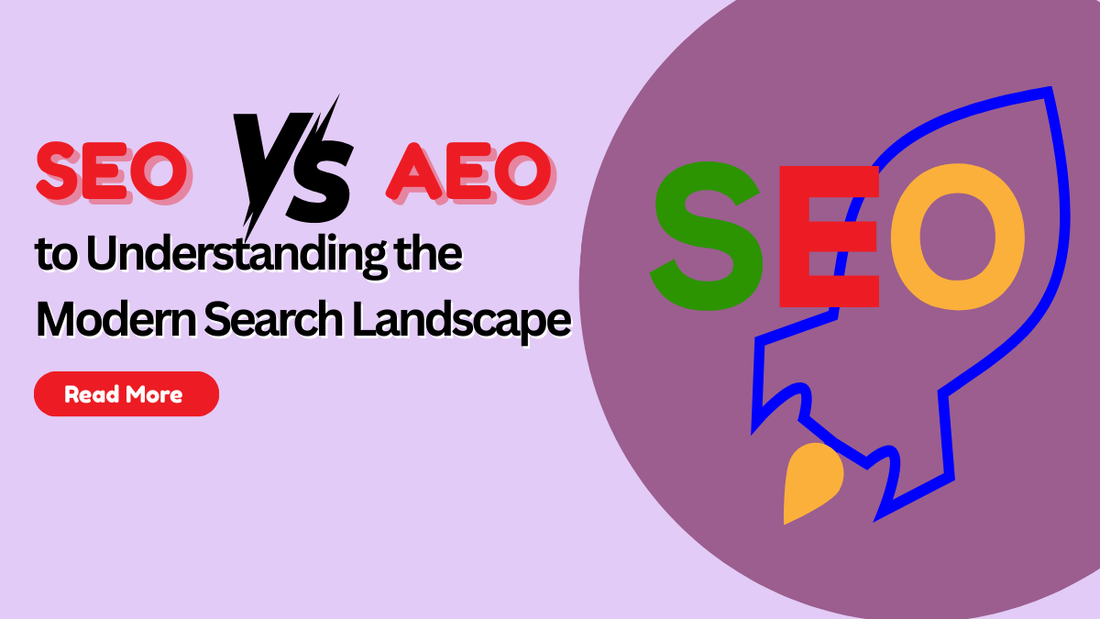
Share
In today’s fast-evolving digital world, simply ranking on search engines is no longer enough. As user behaviour shifts and technology advances, the way people search and the way platforms respond is changing rapidly. Traditionally, Search Engine Optimisation (SEO) has been the cornerstone of digital visibility, helping websites climb the ranks of Google through keyword strategies, backlinks, and technical enhancements.
But now, a new player is emerging: Answer Engine Optimisation (AEO). With the rise of voice assistants, AI-powered search tools like ChatGPT, and Google’s featured snippets, users are no longer just looking for links they’re looking for direct, authoritative answers.
This shift marks a transformation in how content is created, structured, and delivered. While SEO focuses on visibility within search engine results, AEO is all about relevance, clarity, and providing immediate value often without requiring a click at all.
In this blog, we’ll break down the SEO vs AEO in detail, explore how search engines are evolving into answer engines, and discuss how you can adapt your content strategy to thrive in this new landscape.
What is SEO?

In the battle of SEO vs AEO, we will first explore what SEO is, along with its features and importance.
SEO, or Search Engine Optimisation, involves the strategic effort of honing a website to enhance its standing and rank higher in search engine results. This strategic approach is singularly focused on drawing a larger influx of organic traffic. WordPress SEO best practices is essential to improve website visibility, boost organic traffic, and achieve higher rankings on search engines.
Key features -
- Understanding Search Engines: SEO involves understanding how search engines (like Google, Bing, Yahoo) crawl, index, and rank websites. Search engines use complex algorithms to determine which pages are most relevant and authoritative for a given search query.
- Targeting Organic Traffic: Unlike paid advertising (like Google Ads), SEO focuses on earning "free" clicks from users who find your website through the natural search results.
- Improving Visibility: The better your site ranks in search results, the greater the chances users will notice and visit it. The goal is often to appear on the first page of results, as most users don't go beyond that.
Why SEO is Important?
Increased Organic Traffic: Drives more visitors to your site without direct advertising costs.
Improved Visibility and Brand Awareness: Puts your brand in front of a larger audience.
Credibility and Trust: Top search rankings typically convey a sense of reliability and expertise to visitors.
Enhanced User Experience: SEO techniques such as quick page loads and intuitive navigation contribute to a smoother and more enjoyable browsing experience. the best SEO plugin for WordPress can help optimize your site, improve rankings, and drive more organic traffic effortlessly.
Cost-Effectiveness: While it requires ongoing effort, the "cost per click" for organic traffic is zero, making it a highly cost-effective long-term marketing strategy.
What is AEO?

The war of which is best, SEO vs AEO, we are now ready to explore the AEO. AEO, or Answer Engine Optimisation, is the practice of optimising your content to provide direct, concise, and authoritative answers to user queries especially those processed by AI-powered tools and voice assistants.
While traditional SEO is designed to boost webpage rankings in search results, Answer Engine Optimisation (AEO) targets having your content chosen as the top response by tools like Google’s featured snippets, voice assistants such as Siri and Alexa, and AI-driven platforms like ChatGPT, Bing Copilot, or Google’s Search Generative Experience (SGE). A WordPress-bundle offers multiple premium themes and plugins in one package, making it a cost-effective solution for building professional websites.
Key Features -
- Answer-Focused Content: The content is designed to address specific questions immediately, often within the first few sentences. Uses formats like FAQs, how-tos, bullet points, and definitions.
- Structured Data & Semantic Markup: Implements schema markup and structured data to help machines understand the context and relationships in your content.
- Authoritativeness & Trustworthiness: Content must demonstrate expertise, accuracy, and credibility (E-E-A-T principles from Google: Experience, Expertise, Authoritativeness, Trustworthiness).
- Voice & AI Compatibility: Content should be conversational, concise, and context-aware to be easily used by voice assistants and AI bots.
AEO is not a replacement for SEO. Instead, it's an evolution and an essential complement. While SEO still focuses on overall website visibility and driving traffic, AEO ensures that your content is precisely optimised for the direct, answer-driven queries that are becoming increasingly prevalent in the modern search landscape. By blending both, businesses can achieve comprehensive visibility and cater to the diverse ways users seek information online. the best eCommerce theme for WordPress ensures a professional design, smooth shopping experience, and powerful features to grow your online store.
Differences: SEO vs AEO

SEO vs. AEO: While the two strategies are interrelated, they focus on different outcomes and use different techniques. Here’s a side-by-side breakdown:
1. Primary Focus

SEO:
The primary goal of SEO is to drive organic (unpaid) traffic to a website by improving its ranking in traditional search engine results pages (SERPs) for relevant keywords.The core objective is to convert visibility into visits, prompting users to click your link and explore your content.
AEO:
The core aim of AEO is to serve up immediate, brief, and definitive answers to user questions, frequently removing the need for them to ever visit a website. This means optimising content to be easily extracted and displayed by AI-driven search features (like Featured Snippets, Google AI Overviews, People Also Ask boxes) and voice assistants.
2. User Target and Behaviour

SEO:
It caters to a broader range of user intents – informational (researching a topic), navigational, and transactional (making a purchase). Users are often willing to browse multiple results and explore different pages.
AEO:
It primarily focuses on informational, question-based, and conversational queries where users expect immediate, direct answers. It targets "zero-click" searches where the answer is provided right on the SERP or by a voice assistant, reducing the need for a click.
3. Content Structure and Focus

SEO:
It favours comprehensive, in-depth, and often long-form content (blog posts, articles, guides) that covers a topic thoroughly. The goal is to create content that’s both keyword-focused and rich in expertise.
AEO:
It emphasises concise, direct, and factual answers. Content is structured to be easily scannable and extractable by AI. This often involves leading with direct answers, using clear headings, utilising bullet points, numbered lists, and tables, and including dedicated FAQ sections.
4. Optimisation Methods

SEO:
Traditional methods include:
- Extensive keyword research for both short-tail and long-tail keywords.
- Optimising on-page elements like metadata, content relevance, and internal linking.
- Off-page SEO (backlink building, brand mentions).
- Technical SEO (site speed, mobile-friendliness, crawlability).
AEO:
It leverages many SEO fundamentals but adds specific techniques:
- Structured Data (Schema Markup): Crucial for helping AI understand the context and type of information (e.g., FAQPage, HowTo, Article schema).t
- Natural Language Optimisation: Writing in a conversational tone that mirrors how people speak and ask questions.
- Direct Answer Formulation: Specifically crafting sentences or paragraphs that directly answer common questions.
- E-E-A-T (Experience, Expertise, Authoritativeness, Trustworthiness): Building strong signals of credibility is vital for AI to trust and select your content as an authoritative answer.
5. Platforms and Output

SEO:
It primarily targets traditional text-based search engines (Google, Bing) and aims for your website to appear high in the main organic listings.
AEO:
It focuses on AI-powered search features and conversational interfaces: Google's Featured Snippets, "People Also Ask" (PAA) boxes, Google AI Overviews (Generative AI results), Voice search assistants (Siri, Alexa, Google Assistant), Chatbots, and other AI applications that pull information.
SEO and AEO Trends in 2025
The digital search landscape in 2025 is undergoing a significant transformation, driven largely by the pervasive influence of artificial intelligence. Both SEO and AEO are adapting to these shifts, with a growing emphasis on user intent, conversational queries, and the direct provision of answers.
SEO
- Google is integrating AI Overviews into a wider variety of user searches. This means a significant portion of search results will present AI-generated summaries at the top, potentially reducing clicks to traditional "blue links." SEOs will need to optimise content to be precisely what AI models select for these overviews, focusing on clarity, conciseness, and accuracy.
- Google continues to emphasise Experience, Expertise, Authoritativeness, and Trustworthiness (E-E-A-T). Content that demonstrates real-world experience, original research, and is authored by credible individuals or organisations will rank better. Building trust with human audiences and AI algorithms alike depends heavily on this.
- Google is increasingly featuring content from forums and online communities like Reddit and Quora in its SERPs. This highlights the value of authentic, user-generated content and shared experiences. SEO strategies may need to include engaging with and contributing to these communities.
- The focus is shifting even more from just keywords to truly understanding and satisfying user intent. This means creating content that provides the best possible experience, with fast loading times, intuitive navigation, and highly relevant information.
- With the rise of zero-click searches and AI Overviews, traditional organic traffic metrics might see a decline. The emphasis for SEOs will increasingly be on the quality of traffic and its conversion potential, rather than just raw volume.
AEO
- Beyond Google's AI Overviews, dedicated answer engines like Perplexity and AI modes within platforms like ChatGPT are gaining traction as independent search sources. Optimising for these diverse answer engines becomes crucial for comprehensive visibility.
- AEO is designed to thrive in a "zero-click" environment where users get their answers directly on the SERP or from a voice assistant. This requires content to be hyper-optimised for direct answers, structured data (Schema markup), and clear, concise language.
- Voice search continues its growth, making optimisation for natural language queries, long-tail keywords, and localised results (e.g., "near me" searches) a critical AEO component.
- Future AI systems will likely integrate various content formats like video, audio, and images into their answers. AEO will need to adapt to optimise content for these diverse outputs, ensuring visuals have descriptive alt text and videos have clear transcripts.
- As AI becomes more dialogic, content should be structured in a Q&A format, anticipating follow-up questions to facilitate a seamless conversational flow. This also extends to optimising for proprietary search agents and enterprise LLMs.
- As AI systems become more central to information retrieval, the ethical implications of AI-generated content, including potential biases and factual inconsistencies, will be under scrutiny. For AEO to succeed, it's essential to focus on accuracy, clarity, and credibility signals.
Conclusion
The digital search landscape is undergoing a fundamental shift. Though SEO continues to be crucial for boosting visibility and drawing in organic visitors, the emergence of AEO signals a more profound shift in how users look for and want to receive information.
Today’s users want fast, clear, and trustworthy answers, whether they’re typing a query into Google or speaking to a voice assistant. Search engines are evolving into answer engines, and brands that adapt to this shift by combining the strengths of SEO and AEO will stand out in an increasingly competitive space.
To stay competitive in 2025 and the years ahead, the key is not separation, but synergy between SEO and AEO. Using professional WordPress themes helps businesses create visually appealing, secure, and high-performing websites that build trust and engage visitors effectivelyFocus on creating authoritative, well-structured content that not only ranks well but serves real human intent instantly and meaningfully.


